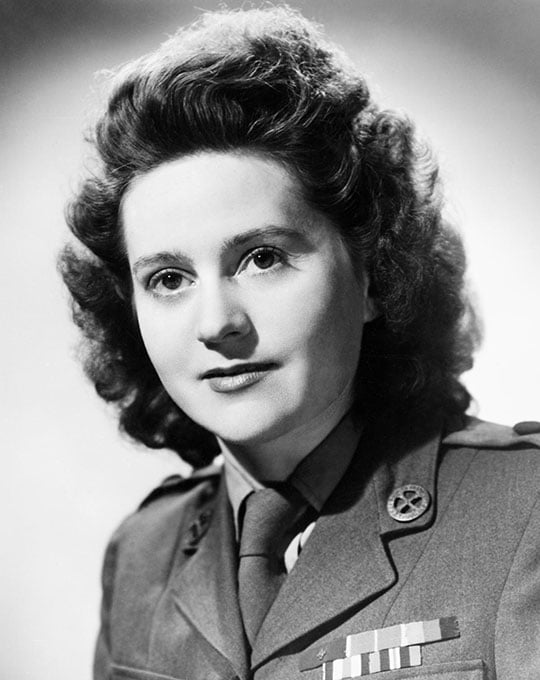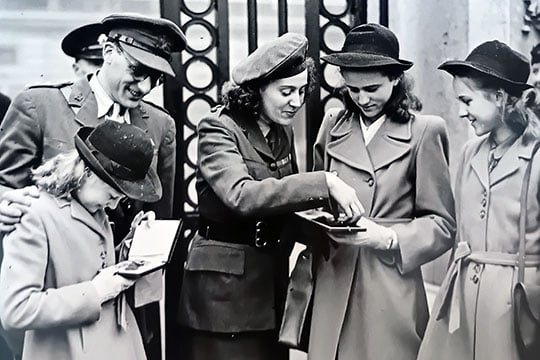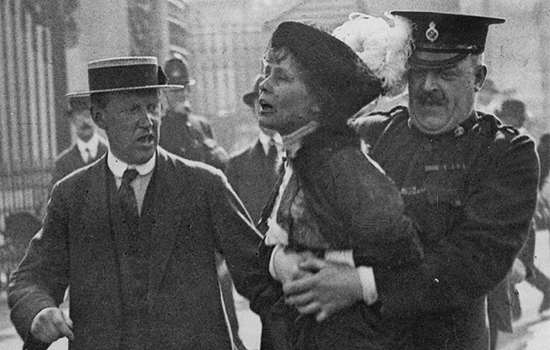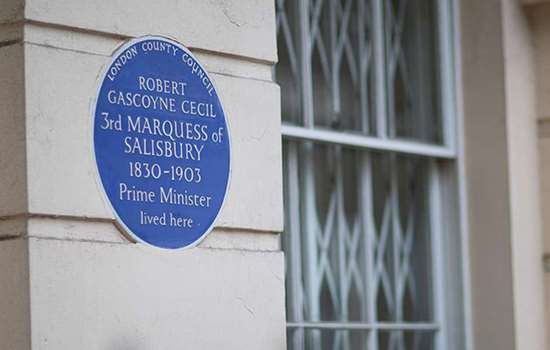SANSOM, Odette (1912–1995)
Plaque erected in 2025 by English Heritage at 6 Lawrence Road, South Ealing, London, W5 4XH, London Borough of Ealing
All images © English Heritage
Profession
SOE Agent
Category
Armed Forces
Inscription
ODETTE SANSOM GC 1912–1995 SOE agent in occupied France lived here
Material
Ceramic
Odette Sansom was a Special Operations Executive (SOE) agent who worked undercover in occupied France during the Second World War. She survived capture and imprisonment and after her return to London on VE Day became the first woman to be awarded the George Cross. She is commemorated by a blue plaque at 6 Lawrence Road, South Ealing, where she lived when the war began.

Odette Marie Céline Brailly was born on 28 April 1912 in Amiens, northern France. She was the daughter of a banker who was killed at Verdun in 1918. Odette suffered severe illness in her childhood, including polio and rheumatic fever, and for several years she was blind and unable to leave her bed.
England and Ealing
In 1931, aged 19, Odette married a British man, Roy Sansom, who was then living in Boulogne. Their first daughter, Françoise, was born in France in about 1933. When Odette was pregnant with their next child, Roy went to England where he found work catering and waiting. Odette followed and was issued a British passport at Lille in September 1933. Lily was born in London in 1934 and a third daughter, Marianne, was born in 1936.
Sansom moved frequently during the 1930s but by June 1939 she was living at 6 Lawrence Road in Ealing with her children, husband, mother and mother-in-law. The house was a typical late 19th-century two-storey terraced house, and it was here that Sansom was living when the Second World War began. By this time, Sansom’s marriage was foundering, and after Roy joined the Army, they had little contact.
SOE
In spring 1942 Sansom responded to a call on the BBC for photographs or knowledge of the coast of France. She was invited to an interview with the SOE and learned of the extremely dangerous nature of their work. After initial hesitation, she agreed to undertake the arduous training programme, which she passed. Women had not previously been allowed in combat roles; she was part of an early intake.
Sansom arranged for her daughters to be cared for, telling them that she was joining the First Aid Nursing Yeomanry (FANY) and would be away for some time. With the codename ‘Lise’, she was sent to France to establish a base in German-occupied Auxerre and recruit a circuit (an undercover network).
In November 1942, she met Captain Peter Churchill, head of the SOE circuit (SPINDLE) in Cannes. He was meant to help her reach the occupied region, but this was not possible, so Sansom became SPINDLE’s courier, delivering messages, instructions and plans. She worked with Peter Churchill and Adolfe Rabinovitch, the circuit’s radio operator, who maintained communications with SOE in London.
About a week after Sansom’s arrival, Germany and Italy occupied all of France. SPINDLE were under surveillance, with Sergeant Hugo Bleicher of German military intelligence on their trail, possibly with the help of a traitor. Sansom warned colleagues to leave the area. She stayed to wait for Churchill to return from a trip, but Bleicher came sooner than expected and arrested them both on 16 April 1943.
Captivity
Sansom hid incriminating evidence and gave their captors Churchill’s real name, saying that he was closely related to Winston Churchill to get him better treatment, and claiming they were married. She pretended to have headed the circuit and was treated harshly. Sansom was interrogated 13 or 14 times and was tortured. By giving nothing away about Rabinovitch or a new SOE operative, Francis Cammaerts, she saved their lives and enabled them to continue their work (although Rabinovitch was later caught and executed).
Sentenced to death as a British spy, Sansom was kept in solitary confinement in Fresnes prison, near Paris, and put on a starvation regime for a period. On 12 May 1944 she and six other SOE women were sent to Germany. All except Sansom were later killed.
In July, Sansom was sent to Ravensbrück Concentration Camp. The inmates were mostly political prisoners and experienced a regime of forced labour, starvation diet, medical experiments, beatings and executions. Sansom was kept in a punishment block known as the Bunker. In August, in revenge for the Allied D-Day landings, the heating in the cell was put on full blast and she was deprived of food for a week.
As Allied forces advanced, Sansom was one of only seven Bunker prisoners not executed. On 3 May 1945, the Ravensbrück Commandant drove her to the American forces, hoping to save himself by saving someone whose name (he thought) was Churchill. Sansom told the Americans to take him prisoner and he was later tried and executed for war crimes.

Later life
Sansom returned to London on 8 May 1945, Victory in Europe Day, when the Allies celebrated Germany’s unconditional surrender. In October 1945 she was appointed an MBE for ‘services in France during the enemy occupation’.
In August 1946 she became the first woman to be awarded the George Cross, for her ‘courage, endurance and self-sacrifice of the highest possible order’. Odette herself noted the heroism of the many SOE agents who had died in captivity. Among them were Violette Szabo and Noor Inayat Khan who were also awarded the George Cross.
Odette Sansom divorced her first husband and married Churchill in February 1947. They later broke up, and she married Geoffrey Hallowes, who had also been in the SOE. The post-war reappraisal of the work of the SOE brought some critical coverage her way; more recent research, however, has underlined the bravery of her actions.
Odette was a vice-president of the FANY from 1967 to 1995, a prominent member of the Victoria Cross and George Cross Association, and supported numerous other charitable causes, including the Poliomyelitis Trust and Amnesty International.
She died at her home in Walton-on-Thames on 13 March 1995.
Further reading
-
Lynette Beardwood, ‘Hallowes [née Brailly], Odette Marie Céline (1912–1995)’, Oxford Dictionary of National Biography (2004) (access with a UK public library card)
-
Penny Starns, Odette: World War Two’s Darling Spy (2009)
-
Jerrard Tickell, Odette: the Story of a British Agent (1949)
-
‘Odette Sansom, GC’, IWM


